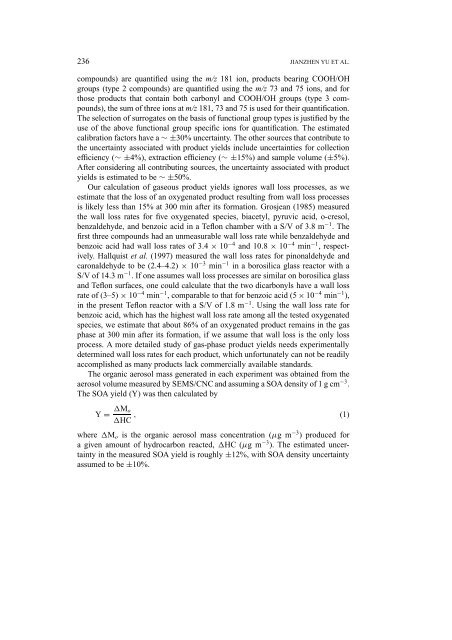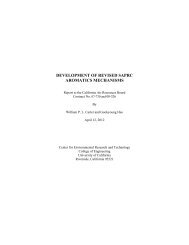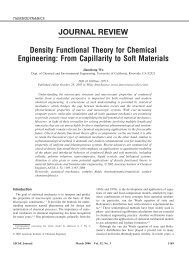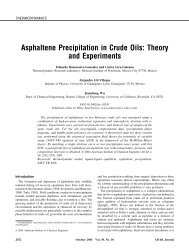Gas-Phase Ozone Oxidation of Monoterpenes: Gaseous and ...
Gas-Phase Ozone Oxidation of Monoterpenes: Gaseous and ...
Gas-Phase Ozone Oxidation of Monoterpenes: Gaseous and ...
You also want an ePaper? Increase the reach of your titles
YUMPU automatically turns print PDFs into web optimized ePapers that Google loves.
236 JIANZHEN YU ET AL.<br />
compounds) are quantified using the m/z 181 ion, products bearing COOH/OH<br />
groups (type 2 compounds) are quantified using the m/z 73 <strong>and</strong> 75 ions, <strong>and</strong> for<br />
those products that contain both carbonyl <strong>and</strong> COOH/OH groups (type 3 compounds),<br />
the sum <strong>of</strong> three ions at m/z 181, 73 <strong>and</strong> 75 is used for their quantification.<br />
The selection <strong>of</strong> surrogates on the basis <strong>of</strong> functional group types is justified by the<br />
use <strong>of</strong> the above functional group specific ions for quantification. The estimated<br />
calibration factors have a ∼±30% uncertainty. The other sources that contribute to<br />
the uncertainty associated with product yields include uncertainties for collection<br />
efficiency (∼ ±4%), extraction efficiency (∼ ±15%) <strong>and</strong> sample volume (±5%).<br />
After considering all contributing sources, the uncertainty associated with product<br />
yields is estimated to be ∼±50%.<br />
Our calculation <strong>of</strong> gaseous product yields ignores wall loss processes, as we<br />
estimate that the loss <strong>of</strong> an oxygenated product resulting from wall loss processes<br />
is likely less than 15% at 300 min after its formation. Grosjean (1985) measured<br />
the wall loss rates for five oxygenated species, biacetyl, pyruvic acid, o-cresol,<br />
benzaldehyde, <strong>and</strong> benzoic acid in a Teflon chamber with a S/V <strong>of</strong> 3.8 m −1 .The<br />
first three compounds had an unmeasurable wall loss rate while benzaldehyde <strong>and</strong><br />
benzoic acid had wall loss rates <strong>of</strong> 3.4 × 10 −4 <strong>and</strong> 10.8 × 10 −4 min −1 , respectively.<br />
Hallquist et al. (1997) measured the wall loss rates for pinonaldehyde <strong>and</strong><br />
caronaldehyde to be (2.4–4.2) × 10 −3 min −1 in a borosilica glass reactor with a<br />
S/V <strong>of</strong> 14.3 m −1 . If one assumes wall loss processes are similar on borosilica glass<br />
<strong>and</strong> Teflon surfaces, one could calculate that the two dicarbonyls have a wall loss<br />
rate <strong>of</strong> (3–5) × 10 −4 min −1 , comparable to that for benzoic acid (5 × 10 −4 min −1 ),<br />
in the present Teflon reactor with a S/V <strong>of</strong> 1.8 m −1 . Using the wall loss rate for<br />
benzoic acid, which has the highest wall loss rate among all the tested oxygenated<br />
species, we estimate that about 86% <strong>of</strong> an oxygenated product remains in the gas<br />
phase at 300 min after its formation, if we assume that wall loss is the only loss<br />
process. A more detailed study <strong>of</strong> gas-phase product yields needs experimentally<br />
determined wall loss rates for each product, which unfortunately can not be readily<br />
accomplished as many products lack commercially available st<strong>and</strong>ards.<br />
The organic aerosol mass generated in each experiment was obtained from the<br />
aerosol volume measured by SEMS/CNC <strong>and</strong> assuming a SOA density <strong>of</strong> 1 g cm −3 .<br />
The SOA yield (Y) was then calculated by<br />
Y = M o<br />
HC , (1)<br />
where M o is the organic aerosol mass concentration (µg m −3 ) produced for<br />
a given amount <strong>of</strong> hydrocarbon reacted, HC (µg m −3 ). The estimated uncertainty<br />
in the measured SOA yield is roughly ±12%, with SOA density uncertainty<br />
assumed to be ±10%.
















